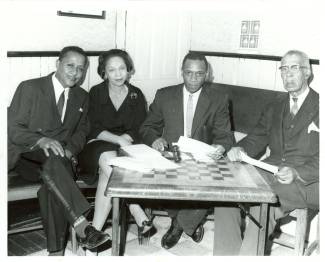Collection Name
About
Romaine Franklin, 1917 - 2016
The National Association for the Advancement of Colored People (NAACP) was founded 1909. This Cumberland News photograph from the late 1950s or early 1960s, depicts an early meeting of the local chapter of the National Association for the Advancement of Colored People (NAACP). Depicted here are, from left to right, Harold Banks, Romaine Franklin, James Hurt, and John Gordon.
Born in Cumberland in 1917, Romaine Franklin is one of two daughters born to the late Charles and Gettie Gilmore Denson. Her mother was a native of Piedmont, West Virginia. Romaine is a 1933 graduate of Frederick Street School, later known as Carver High School. In a 2001 newspaper article she notes that despite living near the old Greene Street Junior High School, segregation required her to walk across town.
Romaine remembers, "You walked regardless of the weather. On those bad, snowy days, you had to pass that (Greene Street) school that was close to where we lived on our way to (Carver) school. It was hard for me to digest." She later graduated from Bowie Normal School where she received a degree in Elementary Education. After one year of teaching, she realized that this was not a profession she wanted to pursue and left teaching to find employment in the private sector.
She began working as an elevator operator at Rosenbaum's Department Store. While working there she became involved with the Union and it was because of her efforts that the elevator workers, all of whom were African-American women, were admitted to the Local 126 Union. During the 1970s and 1980s, she held various administrative positions with the Allegany County Human Resources Development Commission.
Romaine was the granddaughter of Samuel Denson. Born in 1840, Samuel was a run-away slave from Vicksburg, Virginia who arrived in Cumberland during the early part of the Civil War. He became a sexton at the Emmanuel Episcopal Church on Washington Street, which is said to have served as a stop along the Underground Railroad. The double-ringing of Emmanuel's bell meant it was safe for slaves to come to the church for refuge, and many believe Samuel was one of the ringers. In 1890, Romaine's grandfather also helped established St. Philips, a black Episcopal Church begun as a mission of Emmanuel Episcopal. Originally located at the corner of Baltimore and Greene Streets, it later relocated to South Smallwood Street where it served the community until 1960
Romaine was very active in the local NAACP during the 1960s. It was through the NAACP that she focused her energy and talents in recruiting African-Americans for jobs at the Post Office, CSX Railroad, and the Electrical Union just to name a few. She also started the first African-American Girl Scout Troop in Cumberland. Romaine Franklin has dedicated her life to civil rights work.
Romaine Franklin is the widow of the late George Franklin and they had one son, George "Bump" Franklin. She remains a faithful member of the Emmanuel Episcopal Church where she served as a member of the Steward Group, and a past member of the Vestry.
Information from a February 25, 2001 Cumberland Sunday Times newspaper article by James Rada entitled, "Students Handle Hardships of School Segregation", and a February 9, 2004 newspaper article by Maria D. Martirano entitled, "Emmanuel Church Explores Underground Railroad History." Additional information provided by the Carver Community Center Museum.
There does appear to be some ambiguity as to the year a local Cumberland Chapter of the NAACP was established. Based upon information supplied by the Manuscript Division, Library of Congress and pertaining to Martin Erwin, there was an NAACP membership here in 1932. In researching the book, Hidden Stories, Discovered Voices: A History of African Americans in Cumberland, Maryland, high school students note a 1943 newspaper article giving the date as 1938. One possibility might be that 1938 was the year it was officially founded as part of the national organization.
